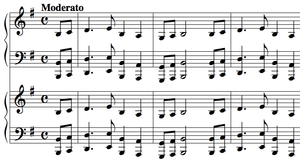
Russian Rhapsody (Rachmaninoff)
Encyclopedia

E minor
E minor is a minor scale based on the note E. The E natural minor scale consists of the pitches E, F, G, A, B, C, and D. The E harmonic minor scale contains the natural 7, D, rather than the flatted 7, D – to align with the major dominant chord, B7 .Its key signature has one sharp, F .Its...
composed by Sergei Rachmaninoff
Sergei Rachmaninoff
Sergei Vasilievich Rachmaninoff was a Russian composer, pianist, and conductor. Rachmaninoff is widely considered one of the finest pianists of his day and, as a composer, one of the last great representatives of Romanticism in Russian classical music...
in 1891, when he was 18. It is more accurately described as a set of variation
Variation (music)
In music, variation is a formal technique where material is repeated in an altered form. The changes may involve harmony, melody, counterpoint, rhythm, timbre, orchestration or any combination of these.-Variation form:...
s on a theme, rather than a true rhapsody
Rhapsody (music)
A rhapsody in music is a one-movement work that is episodic yet integrated, free-flowing in structure, featuring a range of highly contrasted moods, colour and tonality. An air of spontaneous inspiration and a sense of improvisation make it freer in form than a set of variations...
. It was premiered on October 29, 1891, and performance takes approximately nine minutes.
Background

Moscow Conservatory
The Moscow Conservatory is a higher musical education institution in Moscow, and the second oldest conservatory in Russia after St. Petersburg Conservatory. Along with the St...
, Rachmaninoff wrote to Natalia Skalon on mentioning that he had begun work on a piece for two pianos that he wanted to play with Alexander "Sasha" Siloti
Alexander Siloti
Alexander Ilyich Siloti was a Russian pianist, conductor and composer. Alexander Ilyich Siloti (also Ziloti, , Aleksandr Iljič Ziloti) (9 October 1863, near Kharkiv - 8 December 1945, New York) was a Russian pianist, conductor and composer. Alexander Ilyich Siloti (also Ziloti, , Aleksandr Iljič...
. Although, he dated the manuscript
Manuscript
A manuscript or handwrite is written information that has been manually created by someone or some people, such as a hand-written letter, as opposed to being printed or reproduced some other way...
January 12–15, 1891
Old Style and New Style dates
Old Style and New Style are used in English language historical studies either to indicate that the start of the Julian year has been adjusted to start on 1 January even though documents written at the time use a different start of year ; or to indicate that a date conforms to the Julian...
], implying that he had the composition in his head at the time of the letter, and only recorded the days he notated it on paper. Despite his stated intentions, he began rehearsing with Leonid Maximof, who had been a fellow student of Nikolai Zverev
Nikolai Zverev
Nikolai Sergeyevich Zverev was a Russian pianist and teacher known for his pupils Alexander Siloti, Sergei Rachmaninoff, Alexander Scriabin, Konstantin Igumnov, Alexander Goldenweiser, and others.- Life :...
and pupil of Siloti, to play at a student concert at the Conservatory on March 8, 1891. However, Zverev, still upset over Rachmaninoff's request for a separate composing room, did not allow them to play together, so at the concert Rachmaninof ended up conducting his choral
Strophic form
Strophic form is the simplest and most durable of musical forms, elaborating a piece of music by repetition of a single formal section. This may be analyzed as "A A A..."...
work Deus Meus (1890) instead. The Rhapsody received its premiere
Premiere
A premiere is generally "a first performance". This can refer to plays, films, television programs, operas, symphonies, ballets and so on. Premieres for theatrical, musical and other cultural presentations can become extravagant affairs, attracting large numbers of socialites and much media...
after he graduated, on October 29, 1891, in a performance by Rachmaninoff and Josef Lhévinne
Josef Lhévinne
Josef Lhévinne was a Russian pianist and piano teacher.Joseph Arkadievich Levin was born into a family of musicians in Oryol and studied at the Imperial Conservatory in Moscow under Vasily Safonov...
at the Conservatory.
Composition
The piece is more often described as a set of variationVariation (music)
In music, variation is a formal technique where material is repeated in an altered form. The changes may involve harmony, melody, counterpoint, rhythm, timbre, orchestration or any combination of these.-Variation form:...
s rather than a true rhapsody
Rhapsody (music)
A rhapsody in music is a one-movement work that is episodic yet integrated, free-flowing in structure, featuring a range of highly contrasted moods, colour and tonality. An air of spontaneous inspiration and a sense of improvisation make it freer in form than a set of variations...
, and a letter from Rachmaninoff's friend Vladimir Wilshaw describes the possible origin of the composition as a session in which Rachmaninoff improvised on a melody set forth by pianist Yuri Sakhnovsky
Yuri Sakhnovsky
Yuri Sergeevich Sakhnovsky was a Russian composer, conductor and music critic.Sakhnovsky came from a well off family and was known as a "bon vivant handsome, brilliant and wealthy"....
.
Although both he and Lhévinne were more than capable performers, after the premiere, Rachmaninoff considerably simplified three passages. This is cited as the first of many future instances in which he would revise some of his pieces for no apparent reason, since it could not have been the ability of the performers that caused him to do so.

